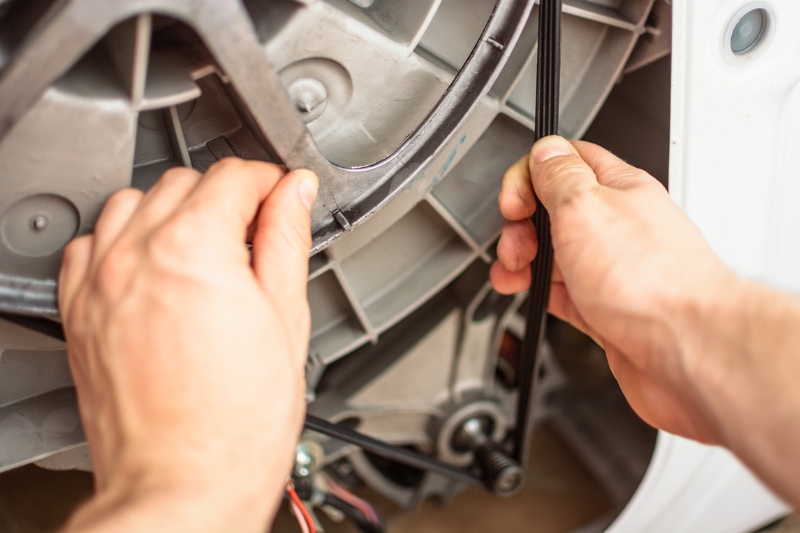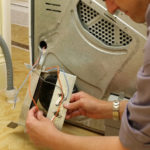The belt in your washing machine is one of the most important parts, and we aren’t talking about the one that holds your trousers up!
A washing machine belt is responsible for taking the energy created by the motor and spinning the drum. If the belt has worn out, broken, or stretched, it may not be able to do this job correctly.
But how do you know if your washing machine belt needs replacing? Well, we discuss all of the common issues that cause problems with the belt, how you can diagnose if the belt is causing your issues, and whether you can replace the belt yourself or not in this article.
Common Washing Machine Belt Problems
The belt in your washing machine is designed to be very long-lasting and should last the lifetime of your washing machine.
However, a tell-tale sign of your washing machine belt becoming an issue is that the drum will no longer spin when you put on a washing cycle.
This can be caused by several different scenarios. If an item of clothing gets stuck between the drum and the housing, for example, this can cause the belt to slip or break entirely. This could be where that missing sock went!
If the blockage isn’t removed, it will cause friction over time, and this can cause the belt to burn or melt.
If the washing machine has been overloaded, this can cause wear on the belt and lead to stretching.
In most scenarios, the washing machine will try to run the cycle and force the drum around. This, of course, can lead to further damage to the drive belt until, eventually, it breaks or becomes too stretched to do the job correctly.
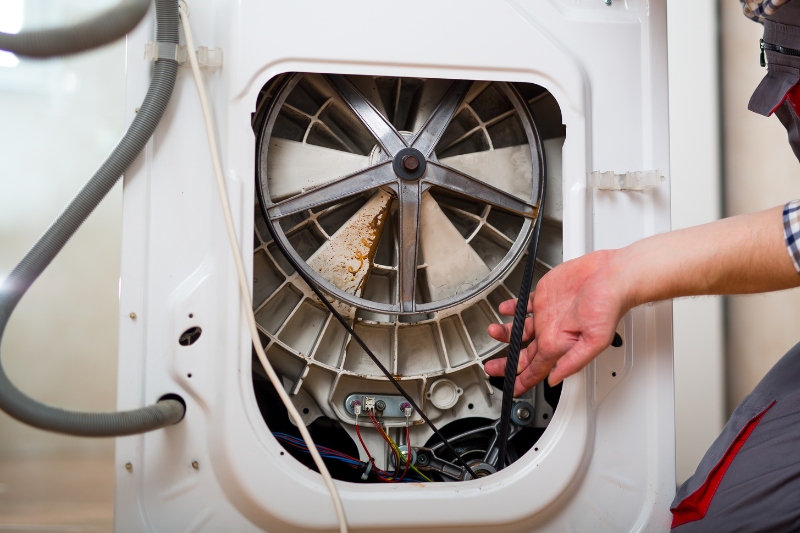
Diagnosing a Bad Washing Machine Belt
If the scenarios above sound similar to what you’re going through, it is likely that the drive belt on your washing machine is bad.
There is a way of diagnosing this, though. You’ll need to unplug your washing machine, disconnect the drain hose and pull it out from the wall.
You can then carefully tilt the washing machine backwards. Have someone help here, and something to prop up the washing machine, a couple of small paint cans, for example.
Take a look underneath your washing machine. You should be able to see the drive belt and motor from here.
Carefully examine the belt to see if there are any burn marks, if it is sitting tightly on the pulleys or whether there are any tears or cracks.
If the belt shows any sign of damage, it will need to be replaced.
Can You Replace a Washing Machine Belt Yourself?
Yes, you can replace a washing machine by yourself, and it is actually quite simple to do and only requires a few tools that you’ll already have if you are a keen DIYer.
We’ll talk you through replacing the belt below, but first, you need to find the correct replacement.
Identifying the Belt You Need

It is much easier to identify which belt you need if you remove it first. To remove the belt from your washing machine, you have to take off the access panel first.
You can remove both the front and back panels of your washing machine (removing the front panel allows for more light to help you to work).
Both panels can be removed by taking out a few screws. If you can’t find any screws, there may be some latches holding the panel in place. You can use a putty knife to help release the latches.
Now that you have access, you’ll be able to clearly see the belt and the motor, although there is sometimes a belt cover blocking it from view.
If your machine has a belt cover, remove this first (there are a few screws holding it in place).
Before you do anything else, take a photo of the belt in place, if it still is in place. This will help if you get stuck installing the new one.
You can now pull the belt off of the drum pulley and the pulley on the motor. If the belt has stretched, this will be fairly easy. If it hasn’t, you can use your screwdriver to pry it off.
Now that you have the belt, you can take a look for any identifying marks on it. Most washing machine belts have numbers printed on them which help you find the exact same belt.
There are many different sizes of belts available, so using these numbers is really important.
If yours doesn’t have any numbers on it, or they have been worn away, the owner’s manual may help you find the correct belt for your machine.
If you don’t have the owner’s manual for your washing machine anymore, you will likely find one on the manufacturer’s website.
How to Replace a Washing Machine Drive Belt
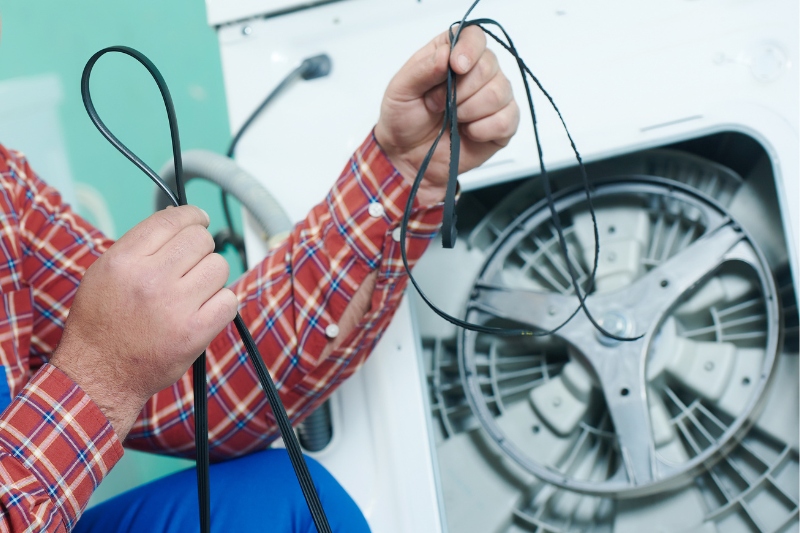
Half of the job is now done. Once you have the correct replacement belt, you can install it in the machine.
To start with, align the belt with the drum pulley, not the motor pulley. The flat face of the belt should be facing outwards, with the ribbed side facing the pulley.
Now secure the belt to the pulley with a zip tie. You’ll be removing this later, but it really helps to line everything up and keep the belt in place during the next step. You’ll want to ensure the belt is making firm contact with the pulley.
Next, you can loop the other end of the belt around the motor pulley. The motor pulley is a small, usually plastic, circular part that will spin the belt.
You’ll need to pull the end of the pulley tightly to allow it to stretch over the pulley. It’s okay if the belt hangs a bit loosely off of the other pulley for now, as long as it is held in place with the zip tie.
Spin the drum of the washing machine by reaching through the door. Slowly spin the drum clockwise.
As you do, the belt should align itself on the pulley and become tight. Keep slowly spinning the drum until you have completed a full rotation.
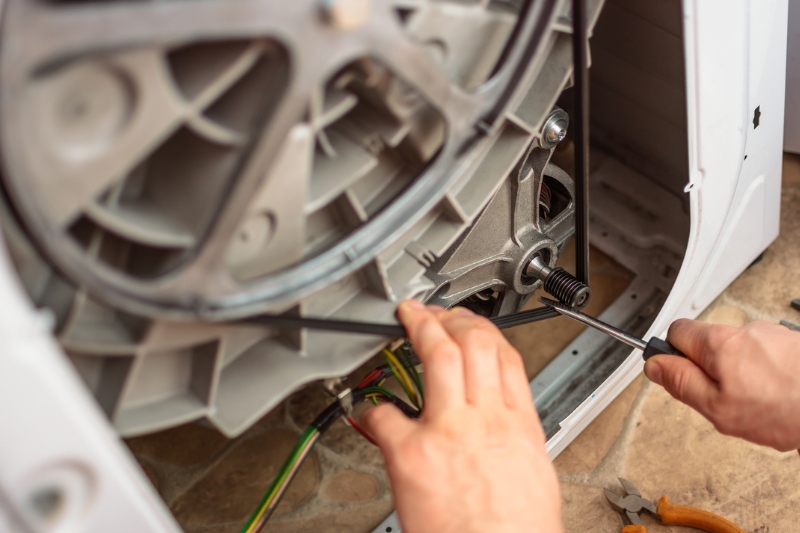
The drum will be a bit difficult to spin, but this is just because the pulley is trying to align itself.
Now you carefully cut the zip tie off, give the drum another spin to check your work and then put the pulley cover (if your machine has one) and any panels you took off back on the machine.
You can are now ready to reinstall the drain hose, plug the machine in and give it a test.
Installing a washing machine drive belt should only take an hour or so, and the only tool you need in most cases is a screwdriver.
We hope this look at identifying and replacing a bad washing machine belt has been helpful. For more common faults like these with lots of appliances, please explore In The Wash further.
We also have lists of the best kitchen appliances like washing machines, tumble dryers and more right here too. So, if the next appliance is beyond repair, we have you covered!

In The Wash is your guide to the best laundry and cleaning products, tips and tricks. Our mission is to solve the UK’s cleaning and laundry dilemmas!
